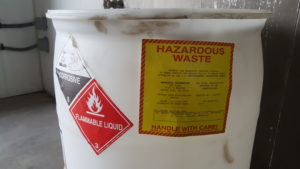This is another article in a series regarding the 2015 Definition of Solid Waste Rule (2015 DSW) and its affect on the regulations of the USEPA, and state agenices. The primary goal of the 2015 DSW was to improve the regulations pertaining to the recycling of hazardous secondary materials. It did this through the creation of new conditional exclusions, e.g. 40 CFR 261.4(a)(27) The Remanufacturing Exclusion for Spent Solvents, and the revision of existing conditional exclusions, e.g. 40 CFR 261.4(a)(23) The Generator Controlled Exclusion and 40 CFR 261.4(a)(24) The Verified Recycler Exclusion. It also revised and strengthened other regulatory requirements of these conditional exclusions (see the entire series of articles). Perhaps after reviewing the available recycling exclusions – not just those identified above, there are many more that were not affected by the 2015 DSW – you have not found one that applies to your recycling operations. If so, you have two options:
- Forget about getting a break from the RCRA regulations and manage your hazardous secondary material as a hazardous waste even as you continue to dispose of it by recycling.
- Apply for and obtain a solid waste variance or a non-waste determination.
Hazardous secondary material means a secondary material (e.g., spent material, by-product, or sludge) that, when discarded, would be identified as hazardous waste under part 261 of this chapter. (40 CFR 260.10)
The purpose of this article is to explain the revisions made by the 2015 DSW to the procedures for obtaining – and maintaining – a non-waste determination or solid waste variance.
FIRST OFF, WHAT IS A NON-WASTE DETERMINATION OR SOLID WASTE VARIANCE?
They exist to provide the generators and recyclers of hazardous secondary materials with a final option to receive a break from full regulation when no other recycling exclusion that applies to them exists in the regulations. They can be found in Title 40 of the Code of Federal Regulations of the USEPA as follows:
- §260.30 Non-waste determinations and variances from classification as a solid waste.
- §260.31 Standards and criteria for variances from classification as a solid waste.
- §260.32 Variances to be classified as a boiler. Not addressed in this article.
- §260.33 Procedures for variances from classification as a solid waste, for variances to be classified as a boiler, or for non-waste determinations.
- §260.34 Standards and criteria for non-waste determinations.
THE 2015 DSW REVISED THE EXISTING SOLID WASTE VARIANCE AND NON-WASTE DETERMINATION REGULATIONS AS FOLLOWS:
§260.31(c):
For a hazardous secondary material that is partially reclaimed but must be reclaimed further before recovery is completed the 2015 DSW…
- Revised the criteria for the application of the variance.
- Added a requirement that the recycling meet the legitimacy criteria of §260.43.
- Requires that all the criteria (§260.31(c)(1-5)) of the variance be met.
§260.33(c):
If there is a change in circumstances after a solid waste variance or non-waste determination has been issued and this change affects how a hazardous secondary material meets the relevant criteria of a solid waste variance or a non-waste determination in §260.31 (for solid waste variance) or §260.34 (for non-waste determination) the applicant must now send a description of the change to the Administrator. The Administrator may do one of the following:
Administrator may be either the USEPA or the environmental regulatory agency of your state depending on the status of the 2015 DSW in your state.
- Issue a determination that the hazardous secondary material continues to meet the relevant criteria of the solid waste variance or non-waste determination.
- Require the facility to re-apply for the solid waste variance or non-waste determination.
Note: "description of the change...) is not the same as the notification required by §260.42.
§260.33(d):
Solid waste variances and non-waste determinations are now effective for a fixed term of ten (10) years. Applicants must re-apply for a solid waste variance or non-waste determination at least six (6) months before the ten year term expires.
§260.33(e):
Facilities that receive a solid waste variance or non-waste determination now must provide a notification by March 1st of every even-numbered year as required by §260.42.
§260.34(b)(4) and §260.34(c)(5):
Facilities requesting a non-waste determination for a hazardous secondary material which is reclaimed in a continuous industrial process per §260.34(b) or a hazardous secondary material which is indistinguishable in all relevant aspects from a product or intermediate per §260.34(c) must now demonstrate why the hazardous secondary material cannot meet, or should not have to meet, any of the recycling exclusions found in §261.2 or §261.4.
This demonstration of no other options available is not required for facilities requesting a solid waste variance.
If your hazardous secondary material or the recycling method you utilize is not addressed by the existing recycling exclusions perhaps a solid waste variance or non-waste determination may be the way to receive some relief from the full weight of the RCRA regulations. Be sure to check with your state to ensure they have implemented the 2015 DSW and if so, that they have adopted these revised solid waste variances and non-waste determinations.
USEPA and your state also mandates the annual training of hazardous waste personnel of a large quantity generator. Contact me for this training at your site or via webinar.

